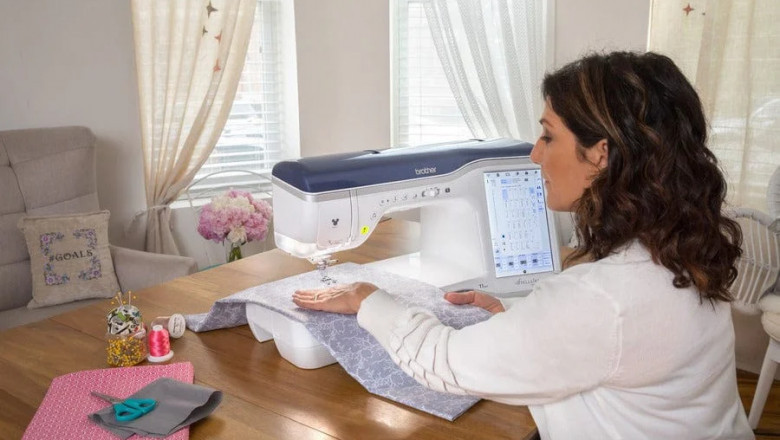views
Introduction
You've probably seen those stunning embroidered portraits or perfect logo recreations and wondered: "How do they turn a simple image into embroidery?" The secret lies in pattern conversion — or more specifically, learning how to convert image to embroidery pattern — a process that's easier to learn than you might think. Whether you want to stitch a beloved pet's portrait, create custom gifts, or expand your embroidery business offerings, mastering the ability to convert image to embroidery pattern opens up endless creative possibilities.
This guide will walk you through the entire process — from selecting the right image to troubleshooting common problems. You'll discover multiple conversion methods suitable for different skill levels and budgets, along with professional techniques that can elevate your embroidery projects from amateur to exceptional. Whether you're just getting started or looking to fine-tune your skills, learning how to convert image to embroidery pattern is the key to unlocking truly personalized stitching.
Understanding the Conversion Process
Converting images to embroidery patterns isn't as simple as changing file formats. It involves translating visual information into stitch data that embroidery machines can interpret. Here's what makes this process unique:
-
Pixel vs Stitch Conversion: Unlike digital images made of colored squares (pixels), embroidery uses thread paths
-
Dimensional Considerations: Embroidery has thickness and texture that flat images lack
-
Color Translation: Converting millions of digital colors to available thread colors
-
Fabric Factors: Different materials require different stitch approaches
Choosing the Right Images
Not all images convert equally well. These characteristics make for the best embroidery patterns:
Ideal Image Qualities:
✔ High contrast between subject and background
✔ Clear, distinct outlines and shapes
✔ One dominant focal point
✔ Good lighting without harsh shadows
✔ Simple color schemes (fewer colors work better)
Poor Candidates for Conversion:
✖ Low-resolution or blurry images
✖ Photos with busy, cluttered backgrounds
✖ Images with subtle gradients or watercolor effects
✖ Group shots with small faces
✖ Dark images with little contrast
Method 1: Free Online Converters
Best for quick, simple projects when you're just starting out:
Recommended Free Tools:
-
EmbroideryDesigns.com - Web-based with free account
-
Online-Convert.com - Handles basic conversions
-
Pic2Pat - Specializes in cross-stitch but useful for inspiration
Pros:
-
No software to install
-
Instant results
-
Good for testing concepts
Cons:
-
Limited control over output quality
-
Often includes watermarks
-
File size restrictions
Method 2: Mobile Apps
Great for converting images on the go:
Top App Choices:
-
StitchSketch (iOS, $4.99) - Simple tracing tools
-
EmbroiderModder (Android) - Free with in-app purchases
-
Pattern Keeper - Helps manage complex designs
Advantages:
-
Work directly from phone photos
-
Some include basic editing features
-
Quick sharing options
Limitations:
-
Small screen makes precision work difficult
-
Few advanced features
-
Output quality varies
Method 3: Dedicated Software
For professional-quality results:
Best Software Options:
-
Hatch Embroidery ($599) - Excellent auto-digitizing
-
SewArt ($70) - Affordable entry-level option
-
Wilcom EmbroideryStudio ($3,000+) - Industry standard
Key Features:
-
Precise stitch control
-
Advanced editing tools
-
Professional file output options
-
Stitch simulation previews
Step-by-Step Conversion Process
Follow this workflow for the best results:
1. Preparing Your Image
-
Crop to focus on the main subject
-
Convert to black and white to check contrast
-
Adjust brightness/levels to enhance edges
-
Simplify complex areas if needed
-
Save as PNG for clean edges
2. Basic Auto-Digitizing
-
Import your prepared image
-
Select appropriate stitch types
-
Set initial stitch density
-
Run the auto-digitizing function
-
Check for obvious errors
3. Manual Adjustments
-
Clean up jagged edges
-
Add registration points
-
Optimize stitch directions
-
Set proper underlay
-
Adjust pull compensation
4. Testing and Refining
-
Stitch a sample on scrap fabric
-
Check for registration issues
-
Adjust tension if needed
-
Make final software tweaks
Understanding Stitch Types
Different stitch types serve different purposes in pattern conversion:
Fill Stitches:
-
Cover large areas
-
Adjustable density and angle
-
Best for solid color sections
Satin Stitches:
-
Create smooth outlines
-
Ideal for text and borders
-
Keep under 8mm width
Running Stitches:
-
Add fine details
-
Create sketch-like effects
-
Good for facial features
Troubleshooting Common Problems
Even with good preparation, you might encounter:
Problem: Design looks distorted when stitched
Solution: Adjust pull compensation settings
Problem: Excessive thread breaks
Solution: Reduce stitch density
Problem: Fabric puckering
Solution: Use appropriate stabilizer
Problem: Colors don't match original
Solution: Manually set thread colors
Pro Tips for Better Conversions
-
Start with simple designs to build skills
-
Fewer colors often produce cleaner results
-
Test frequently on scrap fabric
-
Save successful settings as presets
-
Study both successes and failures
When to Consider Professional Digitizing
Outsourcing makes sense when:
-
Working with complex logos
-
Needing rush turnaround
-
Lacking proper software
-
Wanting specialty effects
The Future of Image Conversion
Exciting developments on the horizon:
-
AI-powered auto-digitizing
-
Cloud-based conversion services
-
Improved mobile apps
-
More intuitive interfaces
Conclusion
Converting images to embroidery patterns is a skill that combines technical knowledge with artistic vision. While the learning curve might seem steep at first, breaking the process into manageable steps makes it approachable for beginners.
Remember that every embroidery artist started where you are now. With practice and patience, you'll develop an eye for what makes images convert well and gain confidence in your ability to troubleshoot problems.
The ability to transform any image into an embroidery pattern opens up incredible creative possibilities. Whether you want to create personalized gifts, expand your business offerings, or simply enjoy a new creative challenge, these skills will serve you well.
Ready to try your first conversion? Choose a simple, high-contrast image and give it a try today. Your first successful converted pattern will be just the beginning of your embroidery journey!














Comments
0 comment